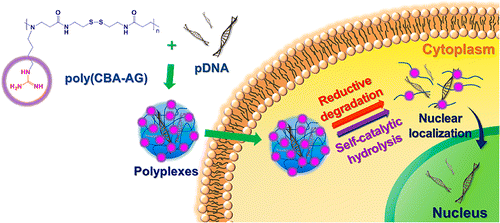当前位置:
X-MOL 学术
›
Biomacromolecules
›
论文详情
Our official English website, www.x-mol.net, welcomes your
feedback! (Note: you will need to create a separate account there.)
Agmatine-Containing Bioreducible Polymer for Gene Delivery Systems and Its Dual Degradation Behavior
Biomacromolecules ( IF 5.5 ) Pub Date : 2015-08-19 00:00:00 , DOI: 10.1021/acs.biomac.5b00590 Ji-yeong Choi 1 , Kitae Ryu 1 , Gyeong Jin Lee 1 , Kyunghwan Kim 1 , Tae-il Kim 1
Biomacromolecules ( IF 5.5 ) Pub Date : 2015-08-19 00:00:00 , DOI: 10.1021/acs.biomac.5b00590 Ji-yeong Choi 1 , Kitae Ryu 1 , Gyeong Jin Lee 1 , Kyunghwan Kim 1 , Tae-il Kim 1
Affiliation

|
Agmatine-containing bioreducible polymer, poly(cystaminebis(acrylamide)-agmatine) (poly(CBA-AG)) was synthesized for gene delivery systems. It could form 200–300 nm sized and positively charged polyplexes with pDNA, which could release pDNA in reducing the environment due to the internal disulfide bonds cleavage. Poly(CBA-AG) also showed a spontaneous degradation behavior in aqueous condition in contrast to the backbone polymer, poly(cystaminebis(acrylamide)-diaminobutane) (poly(CBA-DAB)) lacking guanidine moieties, probably due to the self-catalyzed hydrolysis of internal amide bonds by guanidine moieties. The cytotoxicity of poly(CBA-AG) was cell-dependent but minimal. Poly(CBA-AG) exhibited highly enhanced transfection efficiency in comparison with poly(CBA-DAB) and even higher transfection efficiency than PEI25k. However, cellular uptake efficiency of the polyplexes did not show positive correlation with the transfection efficiency. Confocal microscopy observation revealed that pDNA delivered by poly(CBA-AG) was strongly accumulated in cell nuclei. These results suggested that high transfection efficiency of poly(CBA-AG) may be derived from the efficient pDNA localization in cell nuclei by guanidine moieties and that the polyplexes dissociation via self-catalyzed hydrolysis as well as disulfide bonds cleavage in cytosol also may facilitate the transfection process. Finally, poly(CBA-AG)/pJDK-apoptin polyplex showed a high anticancer activity induced by apoptosis, demonstrating a potential of poly(CBA-AG) as a gene carrier for cancer gene therapy.
中文翻译:

用于基因传递系统的含胍丁胺的生物可还原聚合物及其双重降解行为
合成了含胍丁胺的生物可还原聚合物,聚(胱胺双(丙烯酰胺)-胍丁胺)(聚(CBA-AG)),用于基因递送系统。它可以与pDNA形成200–300 nm大小且带正电荷的多链体,由于内部二硫键的裂解,可以在还原环境中释放pDNA。聚(CBA-AG)在水性条件下也表现出自发降解行为,这与主链聚合物缺乏胍基的聚(胱胺双(丙烯酰胺)-二氨基丁烷)(聚(CBA-DAB))相反,这可能是由于自催化作用胍部分水解内部酰胺键。聚(CBA-AG)的细胞毒性是细胞依赖性的,但微弱。与聚(CBA-DAB)相比,聚(CBA-AG)表现出更高的转染效率,甚至比PEI25k表现出更高的转染效率。然而,复合物的细胞摄取效率与转染效率没有正相关。共聚焦显微镜观察显示,由poly(CBA-AG)传递的pDNA在细胞核中强烈积累。这些结果表明,聚(CBA-AG)的高转染效率可能源于胍基部分在细胞核中的有效pDNA定位,并且通过自催化水解以及在细胞质中二硫键的裂解使多聚体解离也可能促进了聚(CBA-AG)的转染。转染过程。最后,poly(CBA-AG)/ pJDK-apoptin polyplex显示出由细胞凋亡诱导的高抗癌活性,证明了poly(CBA-AG)作为癌症基因治疗的基因载体的潜力。共聚焦显微镜观察显示,由poly(CBA-AG)传递的pDNA在细胞核中强烈积累。这些结果表明,聚(CBA-AG)的高转染效率可能源于胍基部分在细胞核中的有效pDNA定位,并且通过自催化水解以及在细胞质中二硫键的裂解使多聚体解离也可能促进了聚(CBA-AG)的转染。转染过程。最后,poly(CBA-AG)/ pJDK-apoptin polyplex显示出由细胞凋亡诱导的高抗癌活性,证明了poly(CBA-AG)作为癌症基因治疗的基因载体的潜力。共聚焦显微镜观察显示,聚(CBA-AG)传递的pDNA在细胞核中强烈积累。这些结果表明,聚(CBA-AG)的高转染效率可能源于胍基部分在细胞核中的有效pDNA定位,并且通过自催化水解以及在细胞质中二硫键的裂解使多聚体解离也可能促进了聚(CBA-AG)的转染。转染过程。最后,poly(CBA-AG)/ pJDK-apoptin polyplex显示出由细胞凋亡诱导的高抗癌活性,证明了poly(CBA-AG)作为癌症基因治疗的基因载体的潜力。这些结果表明,聚(CBA-AG)的高转染效率可能源于胍基部分在细胞核中的有效pDNA定位,并且通过自催化水解以及在细胞质中二硫键的裂解使多聚体解离也可能促进了聚(CBA-AG)的转染。转染过程。最后,poly(CBA-AG)/ pJDK-apoptin polyplex显示出由细胞凋亡诱导的高抗癌活性,证明了poly(CBA-AG)作为癌症基因治疗的基因载体的潜力。这些结果表明,聚(CBA-AG)的高转染效率可能源于胍基部分在细胞核中的有效pDNA定位,并且通过自催化水解以及在细胞质中二硫键的裂解使多聚体解离也可能促进了聚(CBA-AG)的转染。转染过程。最后,poly(CBA-AG)/ pJDK-apoptin polyplex显示出由细胞凋亡诱导的高抗癌活性,证明了poly(CBA-AG)作为癌症基因治疗的基因载体的潜力。
更新日期:2015-08-19
中文翻译:

用于基因传递系统的含胍丁胺的生物可还原聚合物及其双重降解行为
合成了含胍丁胺的生物可还原聚合物,聚(胱胺双(丙烯酰胺)-胍丁胺)(聚(CBA-AG)),用于基因递送系统。它可以与pDNA形成200–300 nm大小且带正电荷的多链体,由于内部二硫键的裂解,可以在还原环境中释放pDNA。聚(CBA-AG)在水性条件下也表现出自发降解行为,这与主链聚合物缺乏胍基的聚(胱胺双(丙烯酰胺)-二氨基丁烷)(聚(CBA-DAB))相反,这可能是由于自催化作用胍部分水解内部酰胺键。聚(CBA-AG)的细胞毒性是细胞依赖性的,但微弱。与聚(CBA-DAB)相比,聚(CBA-AG)表现出更高的转染效率,甚至比PEI25k表现出更高的转染效率。然而,复合物的细胞摄取效率与转染效率没有正相关。共聚焦显微镜观察显示,由poly(CBA-AG)传递的pDNA在细胞核中强烈积累。这些结果表明,聚(CBA-AG)的高转染效率可能源于胍基部分在细胞核中的有效pDNA定位,并且通过自催化水解以及在细胞质中二硫键的裂解使多聚体解离也可能促进了聚(CBA-AG)的转染。转染过程。最后,poly(CBA-AG)/ pJDK-apoptin polyplex显示出由细胞凋亡诱导的高抗癌活性,证明了poly(CBA-AG)作为癌症基因治疗的基因载体的潜力。共聚焦显微镜观察显示,由poly(CBA-AG)传递的pDNA在细胞核中强烈积累。这些结果表明,聚(CBA-AG)的高转染效率可能源于胍基部分在细胞核中的有效pDNA定位,并且通过自催化水解以及在细胞质中二硫键的裂解使多聚体解离也可能促进了聚(CBA-AG)的转染。转染过程。最后,poly(CBA-AG)/ pJDK-apoptin polyplex显示出由细胞凋亡诱导的高抗癌活性,证明了poly(CBA-AG)作为癌症基因治疗的基因载体的潜力。共聚焦显微镜观察显示,聚(CBA-AG)传递的pDNA在细胞核中强烈积累。这些结果表明,聚(CBA-AG)的高转染效率可能源于胍基部分在细胞核中的有效pDNA定位,并且通过自催化水解以及在细胞质中二硫键的裂解使多聚体解离也可能促进了聚(CBA-AG)的转染。转染过程。最后,poly(CBA-AG)/ pJDK-apoptin polyplex显示出由细胞凋亡诱导的高抗癌活性,证明了poly(CBA-AG)作为癌症基因治疗的基因载体的潜力。这些结果表明,聚(CBA-AG)的高转染效率可能源于胍基部分在细胞核中的有效pDNA定位,并且通过自催化水解以及在细胞质中二硫键的裂解使多聚体解离也可能促进了聚(CBA-AG)的转染。转染过程。最后,poly(CBA-AG)/ pJDK-apoptin polyplex显示出由细胞凋亡诱导的高抗癌活性,证明了poly(CBA-AG)作为癌症基因治疗的基因载体的潜力。这些结果表明,聚(CBA-AG)的高转染效率可能源于胍基部分在细胞核中的有效pDNA定位,并且通过自催化水解以及在细胞质中二硫键的裂解使多聚体解离也可能促进了聚(CBA-AG)的转染。转染过程。最后,poly(CBA-AG)/ pJDK-apoptin polyplex显示出由细胞凋亡诱导的高抗癌活性,证明了poly(CBA-AG)作为癌症基因治疗的基因载体的潜力。











































 京公网安备 11010802027423号
京公网安备 11010802027423号